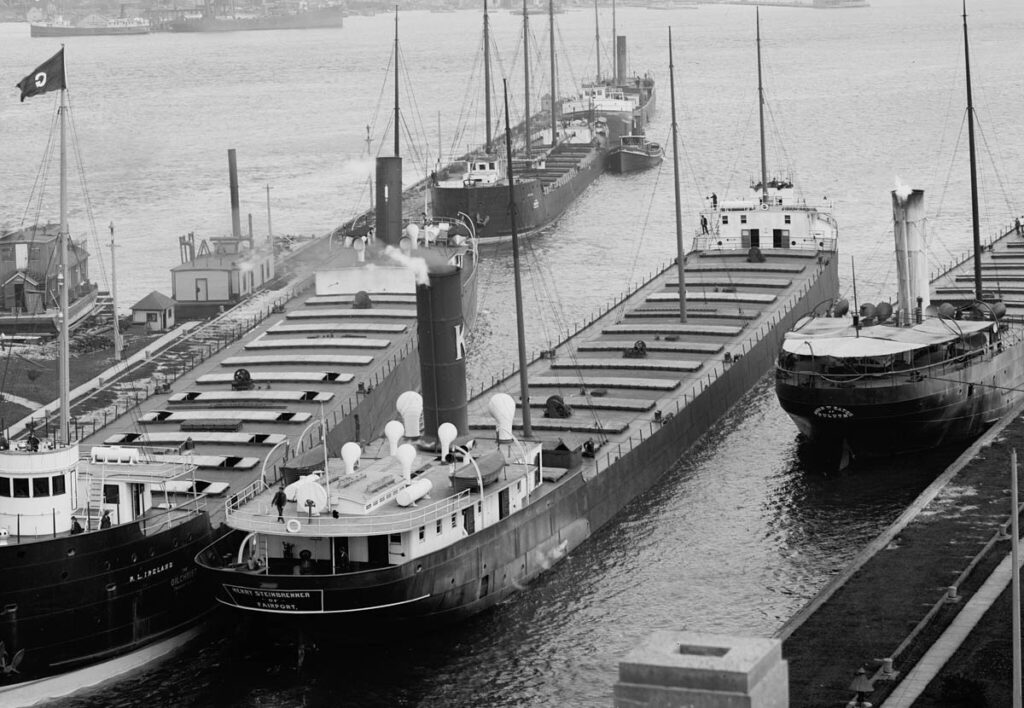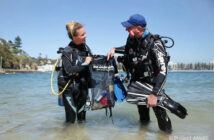The Henry Steinbrenner freighter had a 31-person crew when it sank in a Lake Superior storm in 1953, according to a recent discovery. It went down, south of Isle Royale.
The Great Lakes freighter SS Henry Steinbrenner was primarily built for the iron ore, coal, and grain trades on the Great Lakes. It measured 427 feet (130 m) in length, 50 feet (15 m) in width, and 28 feet (8.5 m) in depth. She was launched as hull number 14 by the Jenks Ship Building Co. of Port Huron, Michigan after being ordered by the Kinsman Transit Co. of Cleveland, Ohio. She had a forward forecastle with crew cabins on top, followed by a cabin and pilot house. With the exception of 12 hatches outfitted with telescoping type hatch covers, the middle section was a long, nearly flat deck over the cargo holds.
The Steinbrenner’s first two decades on the Great Lakes were full of excitement. On December 6, 1909, the Steinbrenner was loaded with iron ore and headed downward when she collided with the nearly-new SS Harry A. Berwind on the St. Marys River. On May 10, 1910, the Steinbrenner was recovered, repaired, and put back into service after it sank in the river and was deemed a total constructive loss. She would go back to her rather uneventful trading routine until she ran into another ship again. She hit the SS John McCartney Kennedy this time in a murky Whitefish Bay, but she was able to stay afloat. After spending $5000 on repairs, she started trading again.

Detroit Publishing Co., Public domain, via Wikimedia Commons
Final Voyage
On May 10, 1953, at 5:11 AM, the 52-year-old ship sailed from Superior, Wisconsin, carrying close to 7000 tons of iron ore for the Lake Erie steel mills. Although the weather was favourable at the time, forecasts for the rest of the day called for rougher conditions. For Captains at this time, setting sail despite unfavourable forecasts wasn’t unusual. The majority of Captains and crews had experienced several storms during their careers, but weather reports were less reliable than contemporary forecasts. Later that afternoon, the forecast gale hit, battering the Steinbrenner with strong winds and huge waves. Captain Albert Stiglin secured his ship’s deck but did not order his crew to cover the twelve “Telescoping” leaf-type hatch covers, which were not watertight and allowed some water to seep into the cargo holds. Around eight o’clock in the evening, one of the leaves on hatch number 11 came loose, allowing water to pour into the hold. Crew members were sent to secure the cover, but as the storm grew more intense, 80 mph (129 km/h) winds and big waves managed to work the leaf loose once more. The storm was forcing open doors and vents, which complicated the situation. It was now too dangerous for crews to be on the deck. Despite the start of the pumps, the flooding persisted. Although Captain Stiglin made an effort to prevent further damage from the waves, by morning other hatch covers had become loose and the ship was struggling to make forward motion.
The ship was doomed as soon as a few more manoeuvres were completed. On May 11, 1953, just after 7:00 AM, an SOS was broadcast. The crew gathered at the forward life raft and the rear lifeboats at 7:35 AM when the whistle signalled an abandon ship. There was confusion as the ship sank, and several men were hurt or ended up in the water. 15 nautical miles (28 km; 17 mi) south of Isle Royale Light, the ship quickly sank. Following the SOS, a search for survivors was launched by the steamers Wilfred Sykes, Joseph H. Thompson (at the time the largest ship on the lakes), D.M. Clemson, D.G. Kerr, William E. Corey, and the Canadian ship Hochelaga.
Six men were taking refuge in the life raft when it was discovered by the Joseph H. Thompson, which was being commanded by Captain Robert F. Leng. One lifeboat was discovered by the D.M. Clemson, which was commanded by Captain Arthur M. Everett. Captain Everett carefully manoeuvred the Clemson to position the lifeboat in the ship’s lee in the face of strong winds and choppy seas, and then had the survivors hoisted aboard with ropes. After that, the men were brought to the captain’s quarters where they were given hot food and clean clothing. The men from the other life boat were saved by the Wilfred Sykes.
17 men ultimately perished in the tragedy. The crew was blamed for not covering the hatches with tarpaulins, but in a storm of that size, even tarpaulins might not have been sufficient to keep the Henry Steinbrenner afloat. The sinking of the Steinbrenner made Great Lakes vessel owners more determined to retrofit some of their older ships with watertight single piece hatch covers.
Norm Bragg, who survived this wreck in Lake Superior, was a watchman on board the SS Daniel J. Morrell when it sank in Lake Huron. He helped that crew understand their plight, gave quick advice and said, “It’s been good to know you.”
17 crew members died and 14 were rescued from the frigid waters.
In September 2023, Jerry Eliason and Ken Merryman found the ship in 750 feet (230 meters) of water, surrounded by its iron ore cargo.








